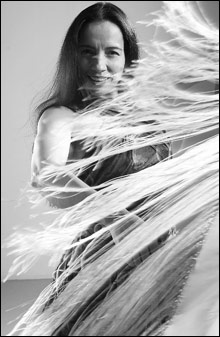
WITH ALL MY SOUL: Clara Ramona got into some extended footwork in her tientos. |
Boston-based Mavi Dance produced the performances of Clara Ramona's "Sangre flamenca en gira" ("Flamenco Blood on Tour") at the Boston University Dance Theater last weekend, but the international dance group offered only two numbers on the long program. There are some interesting affinities between flamenco and the dance traditions of Eurasia's midsection, but we didn't get enough of Mavi to do more than taste the shared flavorings of Spain, the Balkans, and the Middle East.
Flamenco evolved from the stepdances of Europe, the folk dances of roaming Gitanos, the Jewish-Arabic diaspora. It's even tinged with the rhythmic complexities of North India. In the music that accompanied the program you could hear these historical crossings, as well as more recent interactions with jazz and rock. Flamenco is an inexhaustibly syncretic dance/music form, soaking up new cultural influences and then spreading out across the world again. Clara Ramona began her dance studies in Boston, as did her sons Isaac and Nino de los Reyes, but she's returned to teach and perform in her native Philippines, whereas they're now based in Madrid.

Black Sea Variations (choreography by Mavi Dance artistic director H. Pinar Zengingonul) opened the program with a line dance for women in bare-midriff costumes. To Arabic-sounding music, they shook their shoulders and twisted their torsos, reinscribing a feminine prototype. Their rather modest skirling, circling celebration of the body translated into glamour, seductiveness, and temperament, in expansive dances by Clara Ramona and the women of her company. Middle Eastern dance isolates and focuses your attention on the shoulders, hips, and torsos. Flamenco translates these singular attributes into swooping backbends, assertive stamping, large arm gestures and curling hands. And then the added lure of fluttering fan, castanets, voluminous ruffled train.
For these dances, Ramona chose recorded 20th-century orchestral music by Enrique Granados, Manuel de Falla, and Pablo Luna. These lush interpretations of Spanish themes gave a romantic air to the women's dances, showing off their swirling costumes and beautiful arms. The music's long dramatic phrasing encouraged Ramona's big traveling sequences and occasional outbursts of footwork.
Mavi's Svanuri, a Georgian-influenced group dance choreographed by Giorgi Shanidze, laid out a repertoire of distinctive foot patterns in line-dance variations. The eight men and women glided through quick traveling motifs with hitch steps, hop steps, and foot crossings. They advanced with the whole foot contacting the floor, almost slapping the floor, and sometimes a little kick for emphasis. Although the rhythms pressed momentarily into the ground, you got the impression that their momentum was sending them into the air.
Flamenco isn't always gender-specific, but when Isaac and Nino de los Reyes wound up the first half of the program, we saw the "male" side of the style: aggressive percussion dancing in which the two men worked together in complex unison and later revealed their very different, modern personalities. Unaccompanied, they augmented the hammering of heel and toe with their clapping, finger clicks, and body slapping. Nino de los Reyes was a tight, rough mover, escalating his tempo from fast to faster, loud to louder. Isaac surrounded his body with wild arm gestures.
After intermission, Ramona and company appeared in a more conventional format, with singer Leo Triviño leading five musicians and the dancers presenting their arrangements of flamenco styles. Even here, there were multicultural infusions: pianist Alejandro Carrasco's moody jazz rhythms and harmonies, drummer Gerardo Morales's back-up on Indian tablas, and for some numbers an electronic reverb amped into the sound.
Clara Ramona got into a more extended use of footwork in her tientos, Con todo mi alma, her pounding rhythms blending with the musicians' amplified clapping. In Compos duros, a soleá por bulerías, Isaac de los Reyes's stamping seemed to erupt into flamboyant, almost decorative arm gestures. Nino de los Reyes worked up his fast, vibrating foot rhythms in a seguirías, A mi forma, until he was flailing and yanking his whole body around in a not-quite-out-of-control tantrum.